If you are looking to see Yellowstone Animals this is the post for you! We are breaking down the most frequently seen Yellowstone Wildlife and where to find them.
When it comes to a dream vacation moment seeing Yellowstone Wildlife definitely falls into a bucket list moment. From seeing bison in Lamar Valley to Grizzly Bears and Elk there is epic wildlife within this great Wyoming National Park.

Yellowstone Animals
What makes Yellowstone so special is they have been able to bring back the top predator in the food chain, the Yellowstone Wolves. Since the wolves were reintroduced the park has seen dramatic changes in wildlife behavior and landscapes. The wolves help to keep the ecosystem in balance so certain species are not overtaking the park.
There is a lot of controversies you will hear about the Yellowstone Wolves but science and nature are showing how having the top predator back in the park is making a positive impact.
Seeing an intact ecosystem that is healthy and thriving is truly amazing. While in the park you have the opportunity to see a variety of animals that have adapted to living in an environment that includes harsh winters, hot thermal areas, and lots of people.
Visiting Yellowstone NP is amazing for all ages! One thing to always remember is humans are not the top of the food chain within the park. There are predators that can harm you during your visit.
It is also worth noting that being in this ecosystem means that you and your children may see things that are not exactly PG-rated. These Yellowstone Animals are allowing us to be in their area but that does not mean they are not living their full lives including hunting for food and mating to create the next generation.
You will want to prepared for potential conversations with children about what is happening around them.
No trip to Yellowstone National Park is complete without staring in awe at the amazing wildlife roaming through the park.
From Bison to Bears this park is perfect for animal lovers.
Yellowstone is home to 67 species of mammals, 285 species of birds, 16 species of fish, six species of reptiles, and five species of amphibians.
What is the best time to see Yellowstone Animals?
Spring - During springtime, you can enjoy seeing Yellowstone Babies in full force. I mean how can you go wrong with bison babies!
Spring is a great time to see bears feeding in lower elevations before they head to higher elevations and cooler forest areas in the summer.
Summer - During the summer you can see Bison grunt and bellow during the rut.
Fall - During Fall you can see one of the most famous wildlife events in the park the elk rut and mating season.
You can listen to males trying to attract females with bugling and thumping. These grunts echo through Yellowstone.
Wildlife Safety
I can’t write an entire post about Yellowstone Wildlife and not include wildlife safety tips. I am going to share with you some of the scary things we have seen in the park and beg you to not repeat this behavior.
I know that I keep mentioning that wildlife is wild but I honestly worry that this is forgotten in the heat of the moment when visitors see wildlife for the first time.
During our recent visit to Yellowstone, we saw people allow their children to hop out of their cars and run down the road to get closer to the bison. Small children in flip-flops were running along cars to get closer to 2,000+ pound animals that are known to have an interesting temperament at times. I was honestly scared to see what was going to happen next.
We also saw people running towards a grizzly bear and then running away from it when the bear sat up and looked at them. Please remember that most wildlife that are hunters have a strong instinct to chase when something runs from them.
This chase instinct is not personal it is what they need to survive in the harsh environment of Yellowstone. They are instinctively going after a food source and you do not want to be the next target.
Always stay aware of where you are at and what is near you. This includes doing a full 360 to see what other wildlife may be near you. Is there a large bison that has moved in and is blocking you from getting to your car? Did you end up between a mom and her calf?
When pulling over on the side of the road make sure to keep your tires all the way over the white lines. We have seen people almost get knocked out from large RV mirrors being close to their heads. We almost lost a mirror because someone didn’t realize they were driving their RV so close to our car well off the road.
If you are heading out hiking make sure to make noise and your presence known.
If you plan to go hiking or explore the park you may want to carry bear spray with you. While most people do not have to use bear spray it is a safety precaution BUT it only works if you have it within reach. Keeping bear spray in your backpack is not going to help when you come face to face with a bear.
If you are traveling with small children please talk to them about wildlife safety. It is important that they realize and are aware of how large the wildlife in Yellowstone is and what they can do to stay safe.
Do not approach wildlife!
Please maintain a safe distance from all wildlife. A distance of at least 100 yards from bears, bison, and wolves and at least 25 yards from other large animals including moose, deer, elk, antelope, and bighorn sheep.
Carry bear spray when hiking or camping in grizzly country.

Wildlife Watching Tips
Go where the animals are! I know this sounds like common sense but it is worth planning early mornings or late afternoon visits to Lamar Valley, Hayden Valley, and Mammoth Hot Springs depending on the type of wildlife you hope to see.
Make sure you are prepared to sit and wait. Dress in layers, bring binoculars, and or a spotting scope.
Do not feed any animal or bird! Yes, this even includes the squirrels and chipmunks.
As we mentioned above make sure you stay a safe distance away from wildlife. We have seen people get really close to wildlife in Yellowstone and it is downright scary.
Keep your ears open along with your eyes. Listen to the birds and if they quiet down when a large animal is passing nearby.
The early bird gets the worm or in this case the opportunity to view Yellowstone animals. Most wildlife is more active in the early morning or at dusk. They tend to bed down during the heat of the day to save their energy.
If you are looking to see a specific animal take the time to learn a bit more about their habits and where they like to live. A prime example of this is the Yellowstone Wolves. They are known to be seen in the early mornings or at dusk but not often during the heat of the day.

Watch for brake lights and lots of cars stopped in one location. This is normally an indicator that there is some type of animal jam.
Watch for large camera lenses all grouped together. If you see a large number of people with camera lenses longer than your arm it is a fairly good bet that they are looking at a recent carcass to see if Grizzly Bears and Wolves will approach or they are looking at a known area for specific animals.
If you are traveling with kids or want help in identifying the animals of Yellowstone you are seeing we suggest picking up one of these wildlife guides. They are a great help in identifying animals and keeping a checklist for what you have seen in the park.
You may need to visit an area a couple of times to get the full wildlife experience. There are times you drive through Hayden Valley or Lamar Valley and the bison are way off in the distance. Then the next day you may drive through and they are all over the road.
Please remember that Yellowstone Wildlife is WILD! They are living their best lives and not always thinking about trying to get people their post photo opportunities.
Wildlife Photography Tips
One of the best things about Wildlife Photography is digital cameras. You no longer have to stress about only having 24 to 36 shots on a roll of film. You can now shoot to your heart's content.
Wildlife is constantly moving so you will want to take multiple shots to make sure you get the focus where you want it.
Know your equipment and what it is able to do. I have seen people really upset because the photo they took with their phones or iPad did not look like the picture they saw online or on Instagram.
If you are heading to Yellowstone hoping to get an epic dream-worthy wildlife photo you will want to come prepared with the right equipment to get the shot.
We shoot with a Canon Mark 5D IV along with most often a Canon 100-400 image stabilized lens. Even with this large lens we also get lens envy seeing the large Canon 800 mm lenses set up on tripods.
If you are not shooting wildlife often and don’t feel like spending thousands of dollars on a camera lens you can rent a lens by the week for your vacation. This is a great way to get amazing photos without spending the equivalent of a small car on your gear.
I highly suggest practicing with your camera before heading to the park. You can practice taking photos of your pets running or birds in your backyard. Understanding and knowing the way your camera works is a huge step in getting an amazing wildlife photo.
Make sure you have multiple batteries and camera memory cards with you and ready to go. I can fully admit to taking a ton more wildlife photos than I planned in the heat of the moment. The last thing you want is to have your camera tell you the SD card is full and you can’t take any more photos right as the wildlife is looking at you. I had this happen during an Alaska cruise as a humpback whale breached right in front of me and I missed the shot. It is not a moment that I am proud of.
Please do not ask professional photographers to airdrop you their photos. A lot of people that you see out taking photos with giant lenses are making money from their photos. They will not be excited to be asked for their photos for free. I heard this happen multiple times while photographing the wolves in Lamar Valley.
If you are bringing a spotting scope with you to look at the wildlife you can buy an adapter to attach your phone to the spotting scope to get photos. This is a fun way to try and get a close up of wildlife if you are not shooting with a long telephoto lens.

Yellowstone Wolves
One of the most epic animals you can see in Yellowstone is the gray wolves that have been reintroduced. There are multiple packs of wolves within the park including the Lamar Valley Pack and Hayden Valley Pack.
The most frequent sightings of Yellowstone Wolves is in Lamar Valley where a large pack lives. We were able to view a wolf feeding on a dead bison carcass semi-close to the road. I will say that we have only seen wolves on one of our trips to the park and they are not always easy to spot.
Many people will spend hours looking for wolves with spotting scopes in hopes of seeing them in the early morning hours or late in the evening.
We talked to a couple from Florida who spent 12-16 hours of their day looking for wolves in Lamar Valley. They were happy to sit at the pullout on the way to the Slough Creek Campground in hopes of seeing the Lamar Valley pack of wolves in the distance.
If you do see a wolf please make sure to keep a minimum of 100 yards between you and the wolf. Having a great spotting scope and camera lens can make it easier to see the wolves.
Best places to look for Gray Wolves in Yellowstone
Wolves can be seen in other parts of the park but it is not as common.

Bison
Another amazing success story for Yellowstone animals is the amazing bison. It is hard to believe that bison were almost hunted to extinction in the early 1900s.
Today there are over 4500+ bison within Yellowstone National Park. The most common places to see bison in Yellowstone is in Lamar Valley and Hayden Valley though they do pop up in other parts of the park.
You will most likely experience at least one bison jam during your time in the park. This is the moment when the bison decide to take over the road and show just how big they are compared to cars and motorcycles.
One thing to remember is even though bison look like giant fluffy cows they can move their 2,000+ pound bodies at over 35 mph when they want to.
They look docile and cute but they can turn in a split second. We visited the park the last time in August during rut and wow they are something when the males are looking to form a relationship and create the next generation of bison.
Best Places to see Bison in Yellowstone
You can see bison all over Yellowstone. They wander the Old Faithful Geyser basin and other thermal areas.
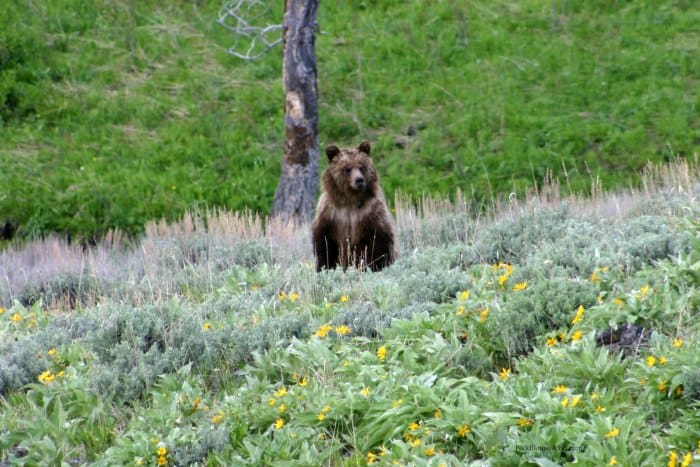
Grizzly Bears
Grizzly Bears are one of the top predators in the Yellowstone eco-system. Grizzly Bears are omnivores which means they eat berries, plants, and other animals. They have a diet rich in a variety of foods which means they can be very opportunistic hunters.
They are happy to feast on a carcass of other animals or a picnic basket that may be left unattended. It is always important to be bear aware while in the park. You will be amazed at how quickly and quietly a Grizzly Bear can move.
You will know it is a Grizzly Bear because they are large and have a hump on their back. They are known to have unpredictable temperaments. They may look like a giant teddy bear you want to hug but one look at their claws will remind you that they can do serious damage.
If you are lucky enough to see a Grizzly Bear in the wild please make sure you try to keep at least 100 yards between you and the bear. PLEASE do not run to or from a bear! We watched people run towards a Grizzly Bear and then run away when the bear started to look at them.
Grizzly Bears are massive and deserve every ounce of respect you can give them.
Best places to look for Grizzlies in Yellowstone:
Dunraven Pass between Canyon Village and Tower-Roosevelt
Lamar Valley between Roosevelt Junction and the northeast park entrance
Near Fishing Bridge on the northern shores of Yellowstone Lake especially in late spring when cutthroat trout are spawning from Yellowstone Lake.

Black Bears
Black Bears are the smaller bear that you will see in the park. It is worth noting that black bears can also be chocolate brown, reddish tan, blond, or jet-black in coloring.
They are smaller than a Grizzly Bear though they still deserve the same amount of respect and safety precautions.
Best places to look for Black Bears in Yellowstone
Blacktail Plateau between Mammoth Hot Springs and Tower-Roosevelt Junction

Coyotes
Coyotes are the smaller of the canine family that you will see in the park. You may wonder how you can tell the difference between a coyote and a wolf and trust me when I say once you see both of them you will know the difference.
Coyotes have a much smaller body including shorter legs and torsos. Wolves and coyotes both feed on similar diets so the introduction of the wolves has helped balance the coyote population in Yellowstone.
Coyotes are scavengers and can be seen in open fields and other areas looking for small rodents, rabbits, and smaller prey.
Best places to see Coyotes in Yellowstone
Hayden Valley
Blacktail Plateau

Moose
Moose are the largest of the deer family that can be found in Yellowstone. You do not hear a ton about Moose in Yellowstone compared to hearing about them in Grand Teton NP south of Yellowstone.
There is a great Moose interpretive panel and information on the park highway between Norris and Mammoth. This is prime habitat for viewing moose and learning more about them.
Moose are another animal to be very cautious around. They are massive and can move quickly. You do not want to get on the bad side of a moose.
If you see a mama moose with a calf please take steps away from them. They are HIGHLY PROTECTIVE of their young and they will move you out of the way.
Best places to see Moose in Yellowstone
Willow Park - between Mammoth Hot Springs and Norris Junction
Phantom Lake northwest of Tower-Roosevelt

Elk
Elk is commonly seen in Yellowstone especially in the Mammoth Hot Springs area and near the Lake Yellowstone lodge and cabins. Elk is another large member of the deer family.
Elk is the most abundant large mammal species in Yellowstone.
If you visit during rut you will hear the elk bugling and herding their harems to keep other males away.
One thing to help identify an elk is their fluffy white butts. I know it sounds funny but a lot of times if you see elk in the distance from the front their coloring blends into the grass and forest easily. When they turn around you can not miss their almost heart-shaped fluffy white butts.
Their butts are one of the easiest ways to identify what you are looking at.
Best places to see Elk in Yellowstone
Gibbon Meadows near Norris Junction
Mammoth Hot Springs

Deer
The smallest member of the deer family that you will see in the park is deer. You may not see a ton of deer during your visit. They are seen sporadically around the park but you most likely will not see a large population of them as you do in other parks.
Mule Deer
You can recognize a mule deer by looking for oversized creamy white ears and black-tipped tail.
Mule Deers are larger than White-tailed deer.
White-Tailed Deer
Whitetails are the most abundant deer species in the lower 48 states.
You can recognize a white-tailed deer by looking for reddish-brown coats, white underbellies, and their tails which are brown on top and white underneath.

Pronghorn Antelope
Pronghorn Antelope is the fastest land animal in the United States. They can reach speeds of 70 miles per hour.
They are most often seen in groups of 5 or more in grassy fields. It is fairly common to see them in Lamar Valley off in the distance.
They are fairly skittish and tend to be seen in the distance.
Best places to see Pronghorn Antelope in Yellowstone
North Entrance - Gardiner, Montana to Mammoth Hot Springs
Lamar Valley
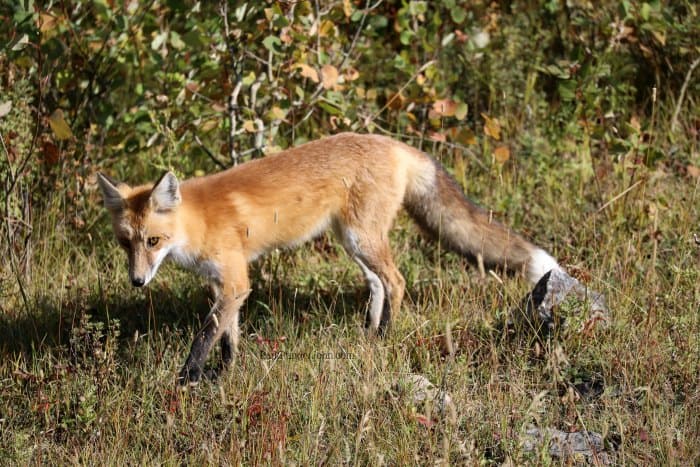
Red Fox
We have seen foxes hunting for small rodents in the fields of Lamar Valley. They are not commonly seen but can be a great sight when you do get to see their bushy tails.
Where to see Red Foxes in Yellowstone
Grand Canyon of the Yellowstone River in the meadows
Canyon Village - in winter, spring, and fall in the meadows they are infrequent.

Least Chipmunks/Uinta Ground Squirrels
Many of us grew up in a time when we were taught to feed the chipmunks and squirrels to get cute family photos. This is a behavior that hopefully is not continuing today.
As a 20-year park ranger, I have to say that most of the animal issues I responded to were people getting bit by the cute little chipmunk they tried to feed.
While chipmunks are cute they can also carry different bacteria and diseases that make getting bit a health issue.
Bighorn Sheep
Bighorn Sheep are not the most common Yellowstone Animal but they can be seen in the park. We have seen them close to the east entrance of the park on the way to Cody and also along the rocks near the Tower Waterfall.
Bighorn Sheep has the amazing ability to climb up rock faces and stay safe from predators.
Best places to look for Bighorn Sheep in Yellowstone
Slopes of Mount Washburn
Tower Falls near Junction Butte

Mountain Goats
Similar to Bighorn Sheep you will most likely see Mountain Goats near large rock walls.
When I first started visiting Yellowstone I had quite an interaction with mountain goats. I sat at a picnic table to sit and watch them from a distance. Over time the mountain goats kept moving around and all of a sudden they were pretty close to me.
I was sitting there enjoying them safely when all of a sudden I heard the squeal of brakes and someone yelling at me. A park ranger was yelling at me for getting too close to wildlife. LOL! It felt like a total role reversal getting yelled at when the mountain goats were the ones approaching the table I sat at.
Words of wisdom from a park ranger that has been yelled at. Always take time to look around you not just through the camera lens. I was so focused on looking through my camera lens that at the moment I didn’t realize just how close the mountain goats had gotten.
While this is a funny story to share you can imagine how this story could have ended if I missed a grizzly bear approaching me.
Mountain Lions/Cougars
While there are Mountain Lions in the park the chances of seeing one are fairly slim. These large cats are shy and elusive. Most people say that they end up seeing mountain lion footprints on the trail as they head back to their car and never realized that a mountain lion was so close to them.
I have spent 20+ years living and working in parks and I have only seen one mountain lion in my entire time exploring parks.
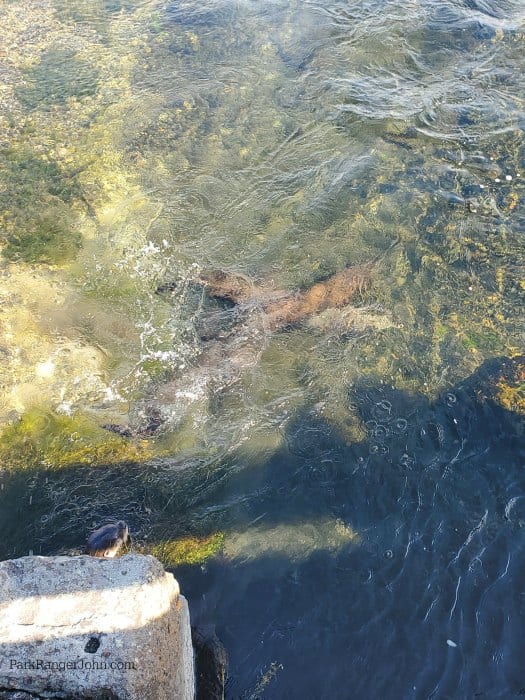
River Otter
We saw River Otters in the Firehole River as we were walking along the bridge leading to the Biscuit Basin.

Bird Watching
Over 311 bird species have been documented in Yellowstone National Park!
The area is a bird watcher's dream! Make sure to bring your binoculars, a Yellowstone Bird Guide, your camera and telephoto lens, and a sense of adventure.
Bald Eagles
One of the most famous spots for birding is 6 miles from the West Entrance to the park on the south side of the road. It is thought that Bald Eagles have nested in this large dead fir tree for over 50 years.
Osprey
Osprey are known as Fish-Hawks and are most frequently seen near water.

Trumpeter Swans
Yellowstone is home to one of the largest populations of Trumpeter Swans in the lower 48 states.
There are two populations of Trumpeter Swans in the park. One flock of Trumpeter Swans spends year-round in the park while the other is a migratory winter flock.
We hope this Yellowstone Animals guide helps you have the best experience in the park!
Fun Yellowstone National Park Tours and Activities
4-Hour Morning Kayak on Yellowstone Lake with Lunch- Admire the tree-fringed banks, beaches, and thermal pools of Yellowstone Lake from the water on this morning tour.
After a kayak lesson and time to familiarize yourself with your kayak, set out to explore the West Thumb with your guide. You will paddle for approximately two miles along the West Thumb Geyser Basin as you look for elk and bear along the lakeshore and marvel at the steaming geysers in this incredible area of the park!
Click here to book your tour for the 4-hour Morning Kayak on Yellowstone Lake with Lunch!
Lamar Valley Safari Hiking Tour with Lunch - the lush riverside plains of the Lamar Valley are a wildlife watching hotspot within Yellowstone National Park. With this guided hike, you get to explore the natural landscapes as you venture off-road and seek out little-known spots, increasing your chances of seeing wildlife. Look out for buffalo, wolves, eagles, and other animals along the way and watch them from a safe distance in their natural habitat. Tour includes lunch, bear spray, binoculars, trekking pole, backpack(if necessary), coffee and/or tea.
Click here to book your tour for the Lamar Valley Safari Hiking Tour with Lunch.
Yellowstone National Park Private Wildlife Tour - Book your private tour with Yellowstone Exposures to ensure a truly unforgettable day with a local expert. Have your day designed and mapped for you by a local professional so that you can utilize it to the fullest.
With snacks, High-quality spotting scopes and binos. Your guide will take photos and video throughout the day. Included a full picnic lunch, snacks, and refreshments.
Click here to book your tour for the Yellowstone National Park Private Wildlife Tour.
Additional Yellowstone Resources
Yellowstone Lodging Guide -Check out all of the lodges you can stay in while visiting Yellowstone NP.
Yellowstone Camping Guide - Check out all of the campgrounds available within the park.
Things to do Yellowstone - Check out all of the top things to do in the park.
Yellowstone Waterfalls - Check out all of the epic easy-to-reach waterfalls in the park.
Yellowstone Facts - Learn more about the unique features in Yellowstone.
Free National Park Days - Check out all of the days the National Park Service waives park entrance fees.
National Parks in Wyoming - Check out all of the parks you can visit while in Wyoming.
Grand Teton NP - Epic guide for planning an amazing visit to the park.
Yellowstone National Park Entrance Fee
Park entrance fees are separate from camping and lodging fees.
Park Entrance Pass - $35.00 Per private vehicle (valid for 1-7 days from the date of purchase)
Park Entrance Pass - Motorcycle - $30.00 Per motorcycle (valid for 1-7 days from the date of purchase)
Park Entrance Pass - Snowmobile - $30.00 Entry for one driver and one passenger (valid for 1-7 days from the date of purchase)
Per-Person Entrance Pass - $20.00 Visitors 16 years or older who enter on foot, bicycle, or as part of an organized group not involved in a commercial tour.
Annual Park Entrance Pass - $70.00, Admits pass holder and all passengers in a non-commercial vehicle. Valid for one year from the month of purchase.
$20.00 for Non-Commercial Group (16+ persons)
$20.00 for Commercial Sedan with 1-6 seats and non-commercial groups (16+ persons) ($25.00 plus $20.00 per person)
$125.00 for Commercial Van with 7-15 seats
$200.00 for Commercial Mini-Bus with 16-25 seats
$300.00 for Commercial Motor Coach with 26+ seats
Learn more about National Park Passes for parks that have an entrance fee.
$80.00 - For the America the Beautiful/National Park Pass. The pass covers entrance fees to all US National Park Sites and over 2,000 Federal Recreation Fee Sites for an entire year and covers everyone in the car for per-vehicle sites and up to 4 adults for per-person sites.
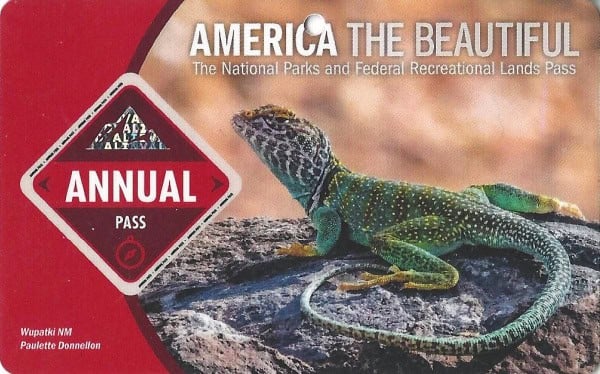
Buy your pass at this link, and REI will donate 10% of pass proceeds to the National Forest Foundation, National Park Foundation, and the U.S. Endowment for Forestry & Communities.
National Park Free Entrance Days -Mark your calendars with the five free entrance days the National Park Service offers annually.
Make sure to follow Park Ranger John on Facebook, Instagram, Pinterest, and TikTok



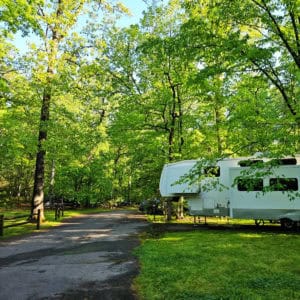

Leave a Reply